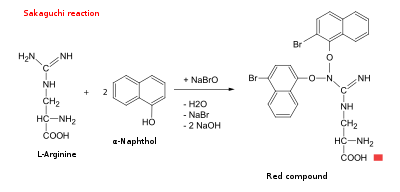Sakaguchi test
The Sakaguchi test is a chemical test used for detecting the presence of arginine in proteins. It is named after the Japanese Food Scientist and Organic Chemist, Shoyo Sakaguchi (1900–1995) who described the test in 1925.[1] Sakaguchi reagent consists of 1-Naphthol and a drop of sodium hypobromite. The guanidine group in arginine reacts with Sakaguchi reagent to form a red-coloured complex.[2][3][4][5]

References
- Sakaguchi, S (1925), "Über eine neue Farbenreaktion von protein und arginin", J. Biochem., 5: 25–31
- Chatterjea (1 January 2004). Textbook of Biochemistry for Dental/Nursing/Pharmacy Students. Jaypee Brothers Publishers. p. 51. ISBN 978-81-8061-204-6.
- R.A. Joshi (2006). Question Bank of Biochemistry. New Age International. p. 64. ISBN 978-81-224-1736-4.
- Dandekar (1 January 2004). Practicals And Viva In Medical Biochemistry. Elsevier India. p. 28. ISBN 978-81-8147-025-6.
- Debajyoti Das (1980). Biochemistry. Academic Publishers. p. 56. ISBN 978-93-80599-17-5.
This article is issued from Wikipedia. The text is licensed under Creative Commons - Attribution - Sharealike. Additional terms may apply for the media files.